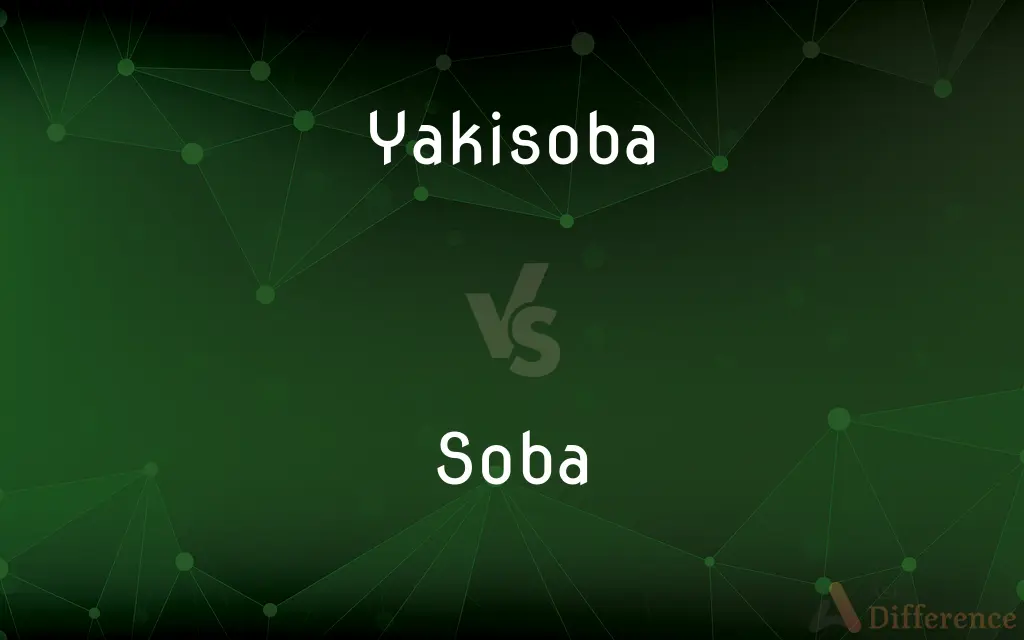Yakisoba vs. Soba — What's the Difference?
By Tayyaba Rehman & Maham Liaqat — Updated on May 1, 2024
Yakisoba, a stir-fried noodle dish made with wheat noodles, contrasts with soba, which features noodles made primarily from buckwheat and served either hot or cold.

Difference Between Yakisoba and Soba
Table of Contents
ADVERTISEMENT
Key Differences
Yakisoba is typically prepared by stir-frying wheat noodles with a mix of meat and vegetables, often seasoned with a savory sauce. In contrast, soba noodles are made mainly from buckwheat flour, giving them a distinct texture and nutty flavor, and they can be enjoyed in various ways, such as chilled with a dipping sauce or in a hot broth.
While yakisoba is recognized for its rich and often spicy flavors enhanced by additions like Worcestershire sauce or similar condiments, soba's appeal lies in its simplicity and the subtle taste of its noodles, which are typically paired with light and sometimes cold broths or sauces.
Yakisoba is usually served hot and garnished with items like pickled ginger, seaweed flakes, and mayonnaise, creating a hearty, meal-like dish. Soba, however, might be garnished with items like green onions, wasabi, and nori, emphasizing its delicate flavor profile.
Whereas yakisoba is often considered a complete meal due to its combination of noodles, protein, and vegetables, soba is frequently served as part of a larger meal, especially in traditional Japanese cuisine, where it may accompany dishes like tempura or sashimi.
Comparison Chart
Main Ingredient
Wheat noodles
Buckwheat noodles
ADVERTISEMENT
Preparation Style
Stir-fried with meat and vegetables
Served hot in broth or cold with dipping sauce
Flavor Profile
Savory, often spicy
Subtle, nutty
Typical Garnishes
Pickled ginger, seaweed flakes, mayonnaise
Green onions, wasabi, nori
Serving Context
Often a standalone meal
Typically part of a larger meal
Compare with Definitions
Yakisoba
A popular street food in Japan, often flavored with a rich, savory sauce.
The yakisoba from the street vendor was especially delicious with its tangy sauce.
Soba
Thin noodles made primarily from buckwheat flour, famous in Japanese cuisine.
We enjoyed cold soba noodles with a dipping sauce during the summer heat.
Yakisoba
A Japanese dish of stir-fried wheat noodles with various meats and vegetables.
I ordered yakisoba at the festival, and it was served with lots of vegetables and chicken.
Soba
Known for its health benefits, including being a good source of protein and fiber.
She switched to soba for its health benefits, appreciating its high fiber content.
Yakisoba
Usually consumed hot and freshly made.
The best yakisoba is eaten steaming hot right from the skillet.
Soba
Soba dishes are subtly flavored to highlight the delicate taste of the noodles.
The soba was served simply with some scallions and a dash of soy sauce.
Yakisoba
A versatile dish that can include a wide range of ingredients according to taste.
For our dinner party, we made yakisoba with shrimp, pork, and lots of green peppers.
Soba
Traditionally served either chilled with a dipping sauce or in a hot, savory broth.
On cold nights, a bowl of hot soba in broth can be very comforting.
Yakisoba
Commonly garnished with pickled ginger, mayonnaise, or seaweed flakes.
He topped his yakisoba with extra pickled ginger and a drizzle of spicy mayonnaise.
Soba
Often eaten on New Year’s Eve in Japan as a symbol of longevity.
Our family always eats soba on New Year’s Eve, following Japanese tradition.
Yakisoba
Yakisoba (Japanese: 焼きそば [jakiꜜsoba]), "fried noodle", is a Japanese noodle stir-fry dish. Usually soba means buckwheat, but soba in yakisoba means Chinese noodles (Chuuka soba) made from wheat flour, and are typically flavored with a condiment similar to Worcestershire sauce.
Soba
Soba (そば or 蕎麦, "buckwheat") is a thin Japanese noodle made from buckwheat. The noodles are served either chilled with a dipping sauce, or hot in a noodle soup.
Yakisoba
A Japanese dish made of fried wheat flour noodles, pork, vegetables and a sweet sauce.
Soba
A kind of Japanese noodle made with buckwheat flour.
Soba
A Japanese buckwheat noodle.
Common Curiosities
What is the main ingredient in yakisoba noodles?
Yakisoba noodles are made from wheat flour.
What makes yakisoba different from other stir-fried noodle dishes?
Yakisoba is specifically made with wheat noodles and a distinct savory sauce.
Is soba suitable for a gluten-free diet?
Pure buckwheat soba is gluten-free, but many varieties contain some wheat flour.
Can soba noodles be eaten cold?
Yes, soba noodles are often served cold with a dipping sauce.
What are typical vegetables found in yakisoba?
Common vegetables in yakisoba include cabbage, carrots, and onions.
What are the health benefits of eating soba?
Soba is low in calories, high in protein, and rich in several minerals.
What type of sauce is commonly used in yakisoba?
A Worcestershire-based sauce is commonly used in yakisoba.
Is yakisoba suitable for vegetarians?
Yakisoba can be made vegetarian, but traditionally it includes meat.
How is soba traditionally served in Japan?
Soba is traditionally served either chilled with a dipping sauce or in a hot broth.
Are there any cultural significances attached to soba?
Yes, eating soba on New Year’s Eve is considered auspicious for longevity in Japan.
How is soba typically cooked?
Soba noodles are boiled and then either cooled or placed directly into hot broth.
What is a typical garnish for soba?
Soba is typically garnished with nori, green onions, and sometimes wasabi.
How do the flavors of yakisoba and soba compare?
Yakisoba is typically savory and sometimes spicy, whereas soba has a subtle, nutty flavor.
Can yakisoba be considered a complete meal?
Yes, yakisoba often includes protein, vegetables, and noodles, making it a complete meal.
What dishes accompany soba in a traditional Japanese meal?
Soba may be served with tempura, sashimi, or other side dishes.
Share Your Discovery

Previous Comparison
Histopathology vs. Cytology
Next Comparison
Nurse vs. SisterAuthor Spotlight
Written by
Tayyaba RehmanTayyaba Rehman is a distinguished writer, currently serving as a primary contributor to askdifference.com. As a researcher in semantics and etymology, Tayyaba's passion for the complexity of languages and their distinctions has found a perfect home on the platform. Tayyaba delves into the intricacies of language, distinguishing between commonly confused words and phrases, thereby providing clarity for readers worldwide.
Co-written by
Maham Liaqat















































